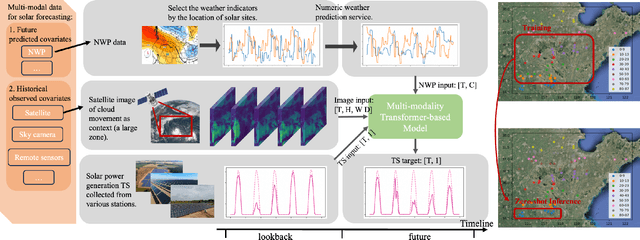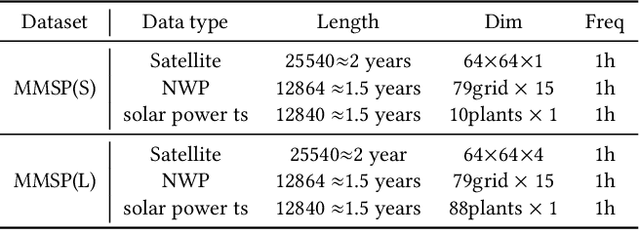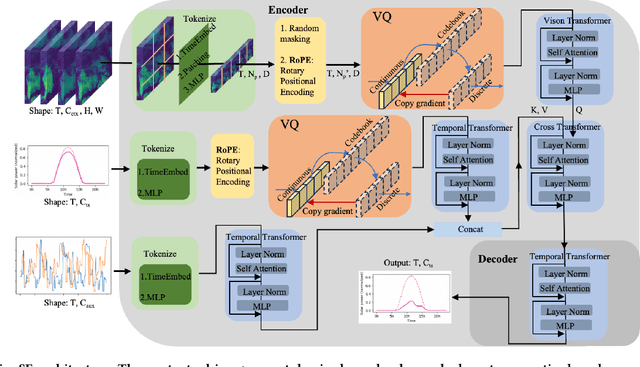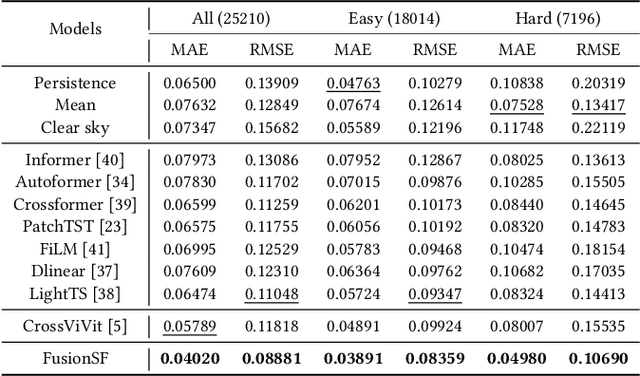Bingqing Peng
FusionSF: Fuse Heterogeneous Modalities in a Vector Quantized Framework for Robust Solar Power Forecasting
Feb 08, 2024



Abstract:Accurate solar power forecasting is crucial to integrate photovoltaic plants into the electric grid, schedule and secure the power grid safety. This problem becomes more demanding for those newly installed solar plants which lack sufficient data. Current research predominantly relies on historical solar power data or numerical weather prediction in a single-modality format, ignoring the complementary information provided in different modalities. In this paper, we propose a multi-modality fusion framework to integrate historical power data, numerical weather prediction, and satellite images, significantly improving forecast performance. We introduce a vector quantized framework that aligns modalities with varying information densities, striking a balance between integrating sufficient information and averting model overfitting. Our framework demonstrates strong zero-shot forecasting capability, which is especially useful for those newly installed plants. Moreover, we collect and release a multi-modal solar power (MMSP) dataset from real-world plants to further promote the research of multi-modal solar forecasting algorithms. Our extensive experiments show that our model not only operates with robustness but also boosts accuracy in both zero-shot forecasting and scenarios rich with training data, surpassing leading models. We have incorporated it into our eForecaster platform and deployed it for more than 300 solar plants with a capacity of over 15GW.
DSAF: A Dual-Stage Adaptive Framework for Numerical Weather Prediction Downscaling
Dec 19, 2023Abstract:While widely recognized as one of the most substantial weather forecasting methodologies, Numerical Weather Prediction (NWP) usually suffers from relatively coarse resolution and inevitable bias due to tempo-spatial discretization, physical parametrization process, and computation limitation. With the roaring growth of deep learning-based techniques, we propose the Dual-Stage Adaptive Framework (DSAF), a novel framework to address regional NWP downscaling and bias correction tasks. DSAF uniquely incorporates adaptive elements in its design to ensure a flexible response to evolving weather conditions. Specifically, NWP downscaling and correction are well-decoupled in the framework and can be applied independently, which strategically guides the optimization trajectory of the model. Utilizing a multi-task learning mechanism and an uncertainty-weighted loss function, DSAF facilitates balanced training across various weather factors. Additionally, our specifically designed attention-centric learnable module effectively integrates geographic information, proficiently managing complex interrelationships. Experimental validation on the ECMWF operational forecast (HRES) and reanalysis (ERA5) archive demonstrates DSAF's superior performance over existing state-of-the-art models and shows substantial improvements when existing models are augmented using our proposed modules. Code is publicly available at https://github.com/pengwei07/DSAF.
WeatherGNN: Exploiting Complicated Relationships in Numerical Weather Prediction Bias Correction
Oct 09, 2023



Abstract:Numerical weather prediction (NWP) may be inaccurate or biased due to incomplete atmospheric physical processes, insufficient spatial-temporal resolution, and inherent uncertainty of weather. Previous studies have attempted to correct biases by using handcrafted features and domain knowledge, or by applying general machine learning models naively. They do not fully explore the complicated meteorologic interactions and spatial dependencies in the atmosphere dynamically, which limits their applicability in NWP bias-correction. Specifically, weather factors interact with each other in complex ways, and these interactions can vary regionally. In addition, the interactions between weather factors are further complicated by the spatial dependencies between regions, which are influenced by varied terrain and atmospheric motions. To address these issues, we propose WeatherGNN, an NWP bias-correction method that utilizes Graph Neural Networks (GNN) to learn meteorologic and geographic relationships in a unified framework. Our approach includes a factor-wise GNN that captures meteorological interactions within each grid (a specific location) adaptively, and a fast hierarchical GNN that captures spatial dependencies between grids dynamically. Notably, the fast hierarchical GNN achieves linear complexity with respect to the number of grids, enhancing model efficiency and scalability. Our experimental results on two real-world datasets demonstrate the superiority of WeatherGNN in comparison with other SOTA methods, with an average improvement of 40.50\% on RMSE compared to the original NWP.
 Add to Chrome
Add to Chrome Add to Firefox
Add to Firefox Add to Edge
Add to Edge